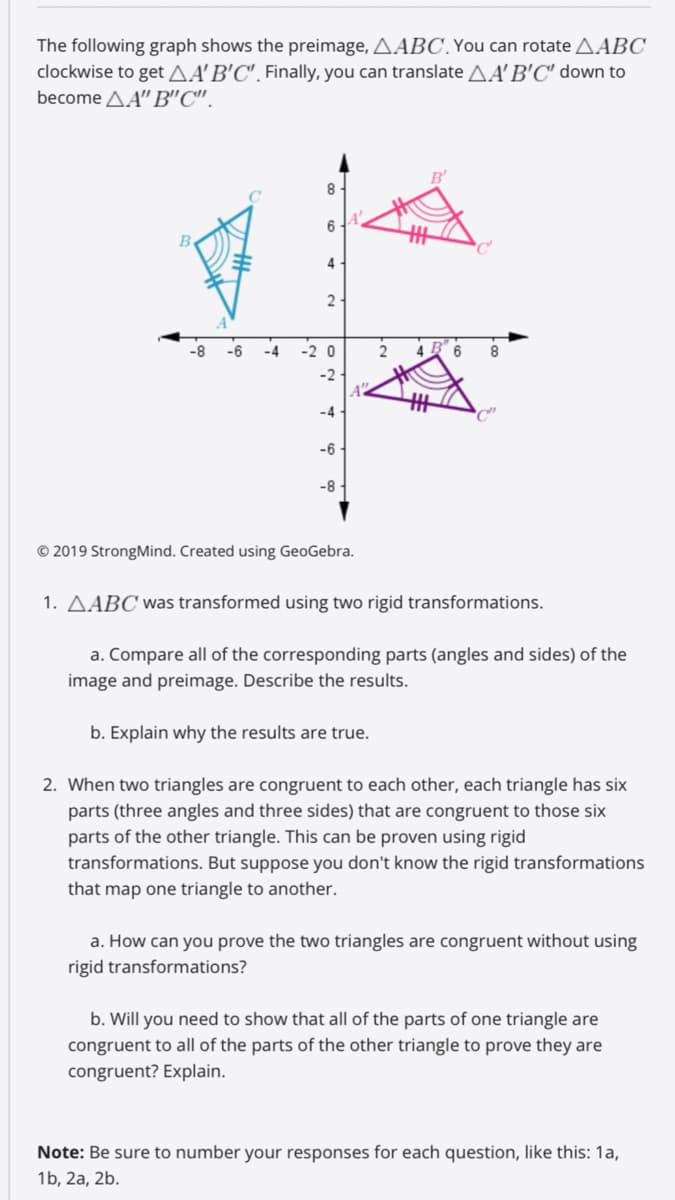The following graph shows the preimage, AABC. You can rotate AABC clockwise to get AA'B'C", Finally, you can translate AA'B'C' down to become AA" B"C". B. 2 -8 -6 -4 -2 0 -2 -6 -8 © 2019 StrongMind. Created using GeoGebra. 1. AABC was transformed using two rigid transformations. a. Compare all of the corresponding parts (angles and sides) of the image and preimage. Describe the results. b. Explain why the results are true.
The following graph shows the preimage, AABC. You can rotate AABC clockwise to get AA'B'C", Finally, you can translate AA'B'C' down to become AA" B"C". B. 2 -8 -6 -4 -2 0 -2 -6 -8 © 2019 StrongMind. Created using GeoGebra. 1. AABC was transformed using two rigid transformations. a. Compare all of the corresponding parts (angles and sides) of the image and preimage. Describe the results. b. Explain why the results are true.
Elementary Geometry For College Students, 7e
7th Edition
ISBN:9781337614085
Author:Alexander, Daniel C.; Koeberlein, Geralyn M.
Publisher:Alexander, Daniel C.; Koeberlein, Geralyn M.
ChapterP: Preliminary Concepts
SectionP.CT: Test
Problem 1CT
Related questions
Question
Can anyone do this

Transcribed Image Text:The following graph shows the preimage, AABC. You can rotate AABC
clockwise to get AA B'C", Finally, you can translate AA'B'C" down to
become AA" B"C".
8.
6
4
2
-8
-6
-4
-2 0
2
8
-2·
-4
-6
-8-
© 2019 StrongMind. Created using GeoGebra.
1. AABC was transformed using two rigid transformations.
a. Compare all of the corresponding parts (angles and sides) of the
image and preimage. Describe the results.
b. Explain why the results are true.
2. When two triangles are congruent to each other, each triangle has six
parts (three angles and three sides) that are congruent to those six
parts of the other triangle. This can be proven using rigid
transformations. But suppose you don't know the rigid transformations
that map one triangle to another.
a. How can you prove the two triangles are congruent without using
rigid transformations?
b. Will you need to show that all of the parts of one triangle are
congruent to all of the parts of the other triangle to prove they are
congruent? Explain.
Note: Be sure to number your responses for each question, like this: 1a,
1b, 2a, 2b.
Expert Solution
This question has been solved!
Explore an expertly crafted, step-by-step solution for a thorough understanding of key concepts.
This is a popular solution!
Trending now
This is a popular solution!
Step by step
Solved in 4 steps

Recommended textbooks for you

Elementary Geometry For College Students, 7e
Geometry
ISBN:
9781337614085
Author:
Alexander, Daniel C.; Koeberlein, Geralyn M.
Publisher:
Cengage,

Elementary Geometry for College Students
Geometry
ISBN:
9781285195698
Author:
Daniel C. Alexander, Geralyn M. Koeberlein
Publisher:
Cengage Learning

Elementary Geometry For College Students, 7e
Geometry
ISBN:
9781337614085
Author:
Alexander, Daniel C.; Koeberlein, Geralyn M.
Publisher:
Cengage,

Elementary Geometry for College Students
Geometry
ISBN:
9781285195698
Author:
Daniel C. Alexander, Geralyn M. Koeberlein
Publisher:
Cengage Learning